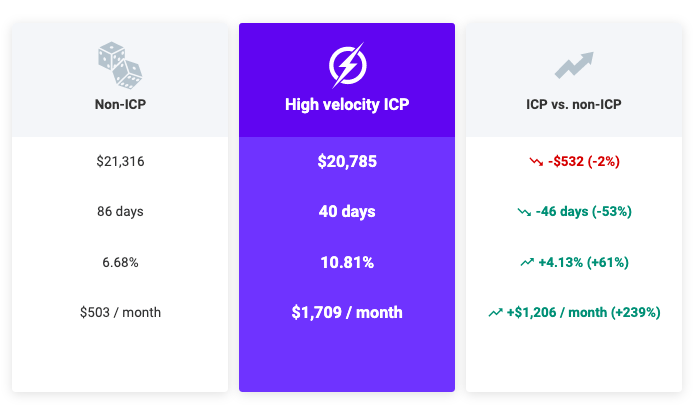When it comes to sales and marketing, one thing is more important than anything else: focusing on the right people within the right companies.
You could have the best product in the world, but if you're selling and marketing to the wrong audience, you'll end up wasting a lot of time and money in the process.
That's why for every account-based campaign it's so important to have a solid, well-thought target account list (TAL).
A target account list is essentially a curated list of B2B companies that are the best match for your product or service and that are the most likely to convert into customers. By having a target account list in place, not only will you save a ton of time and money, but you'll also see a lot more success in your sales and marketing efforts. According to a recent MarketingProfs study, implementing account-based strategies for both marketing and sales can show up to a 208% uplift in marketing revenue.
But how do you actually go about building a target account list?
We'll show you exactly how to build a target account list that will help you close more deals and boost your sales.
When You Need Target Account Lists
Having a curated account list is necessary for businesses looking to reduce wasted spend and boost ROI. Here's why:
- Both sales and marketing understand what exact companies they're going after
- It's easier to make sure the messaging and value propositions are consistent and relevant for every prospect
- Measuring conversions and revenue generated is easier: for each account on the list, you can track its buyer journey using account-based analytics tools
ABM is a type of marketing that's focused on target accounts from day one, rather than casting a wide net and identifying the companies that engage with your content afterward. So instead of trying to attract as many leads as possible and then converting them into customers, you're targeting specific accounts that are more likely to convert, and then you market to them directly.
Here are some examples of account-based marketing campaigns to get inspired by:
Let's now see how to build a target account list for your first campaign in three steps.
3-Step Process To Building A TAL
Not many people know how to build target account lists, and as a result, they either don't have one at all or their TAL is outdated and not very effective.
Don't make the same mistakes!
Follow the three steps below to build a target account list that will actually mean something and that will help you close more deals, win more business, and boost your sales.
1. Define Your TAM
The first step in building your target account list is to define your Total Addressable Market (TAM).
The Total Addressable Market, also known as the Total Available Market, is the revenue opportunity that's available within a given market if 100% market share was achieved.
To put it simply, it's the total amount of revenue that you could potentially generate if you could sell your product or service to everyone in your target market.
Imagine that you're a B2B company that sells software to small businesses.
Your target market might be small businesses in the United States with under 50 employees.
And your target addressable market would be the total revenue that you could generate if you could sell your software to every small business in the United States with under 50 employees.
Defining your target addressable market is important for a few reasons:
- It determines the company's potential for growth
- It allows for financial forecasts and projections
- It determines the effort and resources required
And, of course, it's also a key step in building your target account list because it allows you to narrow down your target market and focus on the accounts that are most likely to generate revenue.
There are 2 approaches you can take when it comes to defining your target addressable market: top-down or bottom-up.
Top-down approach:
The top-down approach is when you begin with the total market size and then break it down into smaller segments. This approach relies on the use of external data sources like market research reports, industry data, and research studies to estimate the total market size.
Bottom-up approach:
The bottom-up approach is when you start with your company's current customer base and then expand outward. This approach relies on the use of primary market research and it's based on previous sales and pricing data.
2. Know your ICP
Once you've defined your target addressable market, the next step is to know your Ideal Customer Profile (ICP).
An Ideal Customer Profile is a description of the company that's the best match for your product or service.
It's based on a number of factors including:
- Company size
- Location
- Industry
- Revenue
- Employee count
And it answers the question: "What type of company would be most likely to buy our product or service and benefit from it the most?"
.webp?width=1469&height=662&name=icp-1%20(1).webp)
An ICP profile built by N.Rich ICP builder
IPCs can help you define problems you are solving for your customers, assist in laying out future roadmaps and help with the target account selection.
To get to know your Ideal Customer Profile, you can start by looking at your current customer base and identifying the patterns and commonalities between them. The more commonalities you find, the easier it will be to create an ICP.
Once you are done with the data, you can start doing qualitative research. This can include interviews with customers, target market research, surveys, and focus groups. Doing this research will allow you to understand your target customers on a deeper level and further refine your ICP.
3. Score Accounts Around Sales Velocity
Now that you know your target addressable market and ICP, it's time to start building out your target account list.
One of the best ways to do this is by scoring accounts around sales velocity.
Sales velocity is the rate at which your accounts are moving through your pipeline and generating revenue.
In other words, it's a measure of how fast an account moves from being a prospect to becoming a customer.
To score your accounts around sales velocity, you'll need to first identify the factors that contribute to a high sales velocity.
These can include:
- The account's budget
- The decision-making process
- The size of the deal
- The accounts fit with your ICP
- The account's need for your product or service
- Previous interactions with the account
Once you've identified these factors, you can start assigning weights to them.
For example, you might decide that the account's budget is worth 30% of the total score, while the account's need for your product or service is only worth 10%.
After you've assigned weights to each factor, you can add up the scores to get a total sales velocity score for each account.
Alternatively, you can use tools like N.Rich that measure sales velocity and score your accounts automatically.

How To Keep TAL Up To Date
Now that you know how to build a target account list, it's important to keep it up to date.
Your target account list should be a living document that evolves as your business grows and changes.
Here are two tips for keeping your target account list up to date:
1. Incorporate feedback from sales
Your sales team is on the front lines and they have a wealth of knowledge about your target market. Make sure to incorporate their feedback into your target account list.
2. Use CRM data to drive decisions
As you start working with your target account lists, you start getting engagement signals and find out that some accounts are responsive. You’ll want to exclude them from campaigns and include new accounts that fit your ICP.
Then you'll start accumulating more data and noticing patterns like:
- "We generate a lot of MQLs from the industry X, but they don't convert into opportunities"
- "Accounts from this particular region convert 2x faster"
- "An average ACV for mid-market is 3x higher"
Use these insights to reorganize and update your target account lists to turn them into revenue-generating machines.
By following the steps above, you can build a target account list that will help you close more deals and grow your business. And by keeping it up to date, you can ensure that your target account list is always accurate and relevant and that you're making the most of your marketing and sales efforts.


.webp?width=1469&height=662&name=icp-1%20(1).webp)


.webp)
.webp)